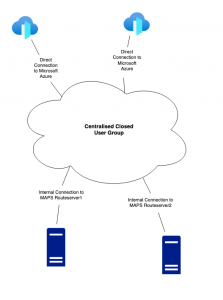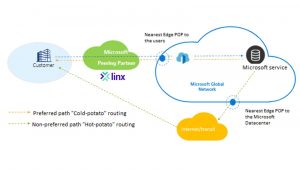A few months ago we launched our exclusive Microsoft Azure Peering Service (MAPS) at LINX Manchester, our regional interconnection hub in the north of the UK.
MAPS provides LINX members with a direct connection to any public Microsoft cloud service, including Microsoft Azure services, Microsoft 365, Microsoft Dynamics 365, or any other Microsoft service accessible via the public internet.
Check out this technical blog by LINX Network Engineer, Michael Heather as he takes you through the deployment process.
After extensive planning and cooperation with Microsoft, we’re very happy to announce the expansion of our MAPS service to LINX Manchester. By doing so, we can now offer the benefits of using this service to more of our members. It also gives our members a new peering service, allowing for a more direct connection with fewer hops to reach Microsoft’s wide variety of services, such as Office 365.
Pre-deployment
The planning before full deployment took some time, mainly communicating back and forth with Microsoft on the set-up details as well as working with the Manchester data centre partners involved to get the required connections installed in order to reach Microsoft Azure.
We also had the opportunity to use the Microsoft Azure Portal to initiate our new connections to them and see how the Azure platform functions in terms of ordering and checking the status of the new connections. Further preparation involved connecting our internal ports to the existing peering route servers in LINX Manchester where MAPS was being deployed. We also had to consider the amount of bandwidth LINX members would need to use on this new MAPS service.
Set-up
The setup at LINX Manchester is similar to our MAPS provision in London on our LON1 network. We have a central Closed User Group that details the connected members and their bandwidth, as well as the connected interfaces our members are using to host their MAPS connections.
We then have two direct connections to Microsoft Azure plus two connections to designated MAPS route server hosts which through vigorous testing and implementation, we were able to deploy a third instance of BIRD and OpenBGPd software to our existing peering route server hosts.
This method was something we hadn’t tried before but following the success, we plan to implement this new setup on our existing LON1 MAPS service, as well as future product expansions on our other exchange platforms such as LINX NoVA in the US… where MAPS is coming soon!
 LINX Microsoft Azure Peering Service ensures all traffic enters and leaves through the nearest Microsoft Edge Point of Presence (PoP) location on the Microsoft Global Network. You also can opt-in to receive additional telemetry data. Served through Microsoft Azure, the service offers latency monitoring and BGP route anomaly detection.
LINX Microsoft Azure Peering Service ensures all traffic enters and leaves through the nearest Microsoft Edge Point of Presence (PoP) location on the Microsoft Global Network. You also can opt-in to receive additional telemetry data. Served through Microsoft Azure, the service offers latency monitoring and BGP route anomaly detection.
Benefits of the LINX Microsoft Azure Peering Service:
- Fully automated ordering process via the LINX portal
- Connect direct to any public Microsoft cloud service
- From ordering to peering in five minutes (existing LINX connected networks)
- Benefit from low latency, reliable uptime, and advanced security